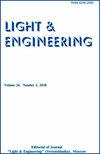Artificial Lighting of Micro-Spaces in Urban Centers
IF 0.3
4区 工程技术
Q4 ENGINEERING, ELECTRICAL & ELECTRONIC
引用次数: 0
Abstract
Night lighting must be taken into account when designing urban public spaces. In urban studies, the urban environment is the support of social processes, and social processes form the requirements for lighting and spatial parameters of the scene. The behaviour of people, their cognitive state and the intensity of communication are the important factors to consider for light design. The key signs of a cognitive state of a person are the number of people around and personal activity mobility. The most characteristic micro-spaces can be selected for various types of environmental behaviour. The paper proposes to use the concept of environmental complexes of micro-, meso-, and macro-spaces for the artificial lighting of a flexible, diverse, but at the same time integral urban environment. Micro-space is perceived as a sphere of personal communication, the so-called “bubble” of social space, and at the same time, micro-space has physical characteristics, including lighting. The basic principles of the light design of the micro-space include such spatial parameters as the size of the “light spot”, the height of the “light ceiling”. Artificial lighting of public spaces reveals the social scenario of using a common space, emphasizes places of communication, meetings, paths of movement, allows you to create a cosy, humane environment.城市中心微空间的人工照明
在设计城市公共空间时,必须考虑到夜间照明。在城市研究中,城市环境是社会过程的支撑,社会过程形成了对场景的照明和空间参数的要求。人们的行为,他们的认知状态和交流的强度是灯光设计的重要考虑因素。一个人的认知状态的关键标志是周围的人的数量和个人活动的流动性。可以为各种类型的环境行为选择最具特征的微空间。本文提出利用微观、中观和宏观空间的环境综合体的概念,为灵活、多样但同时又是整体的城市环境提供人工照明。微空间被认为是一个个人交流的领域,即所谓的社会空间的“泡泡”,同时,微空间具有物理特征,包括照明。微空间灯光设计的基本原则包括“光斑”的大小、“天窗”的高度等空间参数。公共空间的人工照明揭示了使用公共空间的社会场景,强调了交流、会议、运动路径的场所,让你创造一个舒适、人性化的环境。
本文章由计算机程序翻译,如有差异,请以英文原文为准。
求助全文
约1分钟内获得全文
求助全文
来源期刊

Light & Engineering
ENGINEERING, ELECTRICAL & ELECTRONIC-OPTICS
CiteScore
1.00
自引率
50.00%
发文量
0
审稿时长
1 months
期刊介绍:
Our magazine
develops comprehensive communication within the lighting community, providing opportunities for discussion and free expression of opinions of specialists of different profiles;
contributes to the convergence of science and engineering practice, the search for opportunities for the application of research results in lighting and technological applications of light;
keeps the scientific community up to date with the latest advances in the theory of the light field, providing readers with operational professional information;
initiates international cooperation, promotes and distributes the results of Russian authors in the international professional community;
provides equal opportunities for authors from different regions of Russia and other countries.
The journal publishes articles in the following areas:
visual and non-visual effects of radiation on humans;
light field theory;
photometry and colorimetry;
sources of light;
ballasts;
light devices, their design and production technology;
lighting and irradiation installation;
light signaling;
methods of mathematical modeling of light devices and installations;
problems of energy saving in lighting, installation and operation of lighting installations;
modern production technologies of lighting products for lighting control systems;
innovative design solutions;
innovations in lighting and lighting design;
the study of the effect on plants and animals, problems of using light in medicine;
problems of disinfection of premises, water and smell elimination with the help of technology of UV radiation using;
problems of light in the ocean and space.
 求助内容:
求助内容: 应助结果提醒方式:
应助结果提醒方式:


